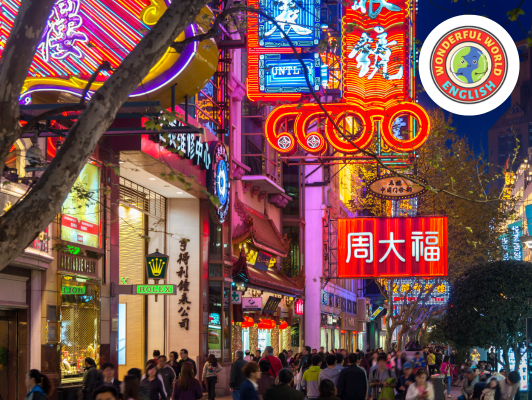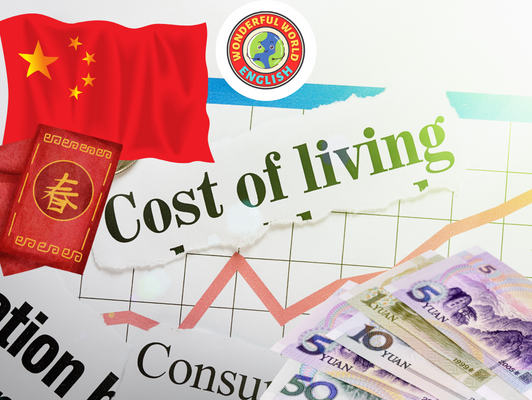Contents
Toggle
Meet David De’ Ath, founder, editor, and writer at Wonderful World English. With his extensive background as an English teacher, David provides valuable insights and practical tips on ESL for students and teachers alike.
Living in China presents an array of economic scenarios depending on location, lifestyle, and personal needs.
With its vast and varied landscape, the cost of living can significantly differ from the bustling megacities like Shanghai and Beijing to the more tranquil inland provinces.
As the world’s most populous country, China’s cost of living is a reflection of the socioeconomic diversity that comes with its sizable population.
The cost of living in China is generally lower compared to Western countries.
Expenses such as food, transportation, and utilities are reasonably affordable, but this affordability is juxtaposed with the high cost of housing in major cities.
Essentials like groceries or dining out can offer savings for expatriates and locals alike, provided they adapt to the local diet and shopping habits.
China has experienced rapid economic development, which has led to increased living costs over time, especially in urban areas.
However, the nation still provides a cost-effective alternative for those looking to reside abroad.
The average expenses for a family or an individual vary greatly, emphasizing the importance of understanding the specific costs associated with the region of interest within the country.
Housing and Accommodation
Housing and accommodation costs in China present a fascinating spectrum, reflecting the vast diversity in geography, economic development, and lifestyle preferences across the country.
While cities like Beijing and Shanghai often capture headlines for sky-high property prices and rental rates, other regions offer a more nuanced picture.
Let’s explore the costs associated with housing and accommodation across various areas of China, including some lesser-known cities and the giants:
Rental Costs
As noted, major metropolises such as Shanghai and Beijing are prominent when discussing rental expenses.
These cities are financial and political hubs attracting domestic and international residents, which drives up housing costs.
- Beijing: Monthly rents for a furnished 85 m2 (approximately 900 sqft) apartment range from ¥7,000 to ¥15,000. Prices vary significantly based on proximity to city centers and amenities.
- Shanghai: Generally, rental costs are about 20% higher than in Beijing for comparable accommodations.
Expanding beyond these giants, other cities like Chengdu and Shenzhen also offer interesting contrasts:
- Chengdu: Known for its laid-back atmosphere and growing tech industry, Chengdu’s housing is more affordable. A similar 85 m2 apartment might cost between ¥3,000 to ¥7,000 per month depending on the district.
- Shenzhen: A tech hub close to Hong Kong, Shenzhen has seen its rental prices soar. Here, you might pay from ¥8,000 to ¥18,000 for similar living spaces.
Utilities
Utility costs can vary but are generally more stable across the country compared to rents.
- Monthly utilities for an 85 m2 flat usually fall between ¥500 and ¥1,000, depending on usage patterns.
- In Beijing, the average monthly utility bill for a moderate two-person household is about ¥905.
Cities like Xi’an and Hangzhou may see slightly lower utility costs due to different climate conditions and local government policies.
Purchasing Property
The property market in China is complex, especially for foreigners who face certain restrictions.
- In Beijing and Shanghai, the cost per square meter in the city center can exceed ¥50,000, reflecting their status as premium markets.
- In contrast, in cities like Nanjing or Tianjin, prices for city center properties start around ¥20,000 per square meter, offering more accessible entry points into the housing market.
Lesser-known cities, often referred to as tier-2 or tier-3 cities like Kunming or Dalian, can be significantly cheaper.
These areas might see prices starting from just ¥10,000 per square meter, making them attractive for those looking for affordability.
| City | Monthly Rent for 85 m² Apartment (¥) | Utilities (Monthly Average, ¥) | Purchase Price Per Square Meter (City Center, ¥) |
|---|---|---|---|
| Beijing | 7,000 – 15,000 | 905 | 50,000+ |
| Shanghai | 8,400 – 18,000 | 500 – 1,000 | 60,000+ |
| Chengdu | 3,000 – 7,000 | 500 – 800 | 15,000 – 25,000 |
| Shenzhen | 8,000 – 18,000 | 500 – 1,000 | 70,000+ |
| Nanjing | 4,000 – 8,000 | 500 – 800 | 20,000 – 30,000 |
| Tianjin | 3,500 – 7,000 | 400 – 700 | 20,000 – 30,000 |
| Kunming | 2,000 – 5,000 | 300 – 600 | 10,000 – 20,000 |
| Dalian | 2,500 – 6,000 | 400 – 700 | 10,000 – 20,000 |
| Chongqing | 2,000 – 6,000 | 300 – 600 | 12,000 – 22,000 |
| Xi’an | 2,500 – 5,500 | 400 – 700 | 15,000 – 25,000 |
| Guangzhou | 5,000 – 10,000 | 500 – 800 | 25,000 – 40,000 |
| Hangzhou | 4,500 – 9,000 | 500 – 800 | 25,000 – 35,000 |
If you’re interested in exploring China, teaching could be your ticket in!
Check out the guide below for everything you need to know on teaching in China!
Related: How to Teach English in China: Your Ultimate Guide

Food and Groceries
Food and groceries in China encapsulate a vast range of costs, influenced by the choice between local markets or supermarkets, dining preferences, and types of beverages one might purchase.
Here’s an expansion of these aspects, including more specific items and options across various parts of the country.
Supermarkets and Markets
In Chinese supermarkets, there’s a rich assortment of both local and international products, which generally allows for a broader price range due to import taxes and local availability.
- Rice and Produce: As noted, a kilogram of rice costs around ¥6.61. Other staple vegetables such as potatoes and tomatoes cost approximately ¥3.30 and ¥7.71 per kilogram, respectively.
- Proteins: Besides the mentioned boneless chicken breast at ¥20.68 per kilogram, pork—a staple in Chinese cuisine—ranges from ¥25 to ¥40 per kilogram depending on the cut and quality.
- Fruits: Detailed prices for bananas, apples, and oranges reflect the typical costs, but seasonal fruits like lychees or dragon fruit can vary greatly, usually costing between ¥20 and ¥50 per kilogram during their respective seasons.
- Dairy and Eggs: Prices for a dozen eggs sit around ¥11.71, and local cheeses, which are less common in traditional Chinese diets, are priced higher, around ¥91 per kilogram.
Dining Out
Eating out in China can accommodate all types of budgets and culinary preferences, from local eateries to more sophisticated dining options.
- Street Food: For those looking to grab a quick, inexpensive bite, street food options like baozi (steamed buns) or jianbing (a type of Chinese crepe) typically cost between ¥5 to ¥15 each.
- Fine Dining: At the higher end, dining in upscale restaurants, particularly in cosmopolitan areas like Shanghai or Guangzhou, can cost anywhere from ¥300 to over ¥1,000 for a multi-course meal for two.
Alcoholic Beverages
Alcohol prices vary depending on whether purchases are made in retail stores or consumed in bars and restaurants.
- Retail Prices: Besides local beers priced around ¥4 per 500ml, imported beers and wines have a higher cost, generally starting from ¥15 and ¥50 per bottle respectively.
- Dining Establishments: In restaurants, a domestic beer typically costs about ¥15 to ¥30, whereas imported beers and cocktails can range from ¥30 to ¥80, reflecting the added costs of service and atmosphere.
Additional Grocery Items
Expanding further, here are a few more common grocery items and their typical prices:
- Seafood: Fresh local seafood like fish can cost between ¥30 to ¥100 per kilogram, depending on the variety and locality.
- Snacks and Convenience Foods: Items like instant noodles are extremely affordable, around ¥2 to ¥6 per package, appealing to budget-conscious consumers.
- Condiments and Spices: Essential for Chinese cooking, items like soy sauce and Sichuan peppercorns are usually priced around ¥5 to ¥15 per bottle or package.
| Item | Average Price in Supermarkets (¥) |
|---|---|
| Rice (1 kg) | 6.61 |
| Potatoes (1 kg) | 3.30 |
| Tomatoes (1 kg) | 7.71 |
| Eggs (dozen) | 11.71 |
| Local cheese (1 kg) | 91 |
| Chicken breast (boneless, 1 kg) | 20.68 |
| Beef round (1 kg, local) | 60 – 80 |
| Apples (1 kg) | 15.87 |
| Bananas (1 kg) | 11.31 |
| Oranges (1 kg) | 12.89 |
| Water (1.5 liter bottle) | 2 – 4 |
| Local beer (500 ml bottle) | 4 |
| Imported beer (330 ml bottle) | 15 – 30 |
| Bottle of mid-range wine (750 ml) | 50 – 150 |
| Pack of cigarettes (Marlboro) | 20 – 30 |

Transportation
Transportation in China is incredibly diverse and efficient, catering to the needs of millions of people across sprawling urban landscapes and more rural areas.
This diversity is reflected in the cost and availability of various transportation options, ranging from public transit to private vehicle ownership, and the increasingly popular taxis and rideshares.
Public Transit
Public transportation is the lifeblood of urban mobility in China, particularly in large cities.
- Shanghai: As noted, a monthly pass for unlimited use of public transport like buses and subways costs around ¥200. Shanghai’s metro system is expansive, connecting major city areas and surrounding suburbs efficiently.
- Beijing: Known for its vast and punctual subway system, Beijing also offers a similar monthly pass costing about ¥150-¥200, depending on the zones covered.
Other cities like Guangzhou and Chengdu also provide extensive public transit systems, with comparable pricing for monthly passes, ensuring affordability for daily commuters.
Vehicle Ownership
Owning a private vehicle in China involves several costs:
- Purchase Price: A new Volkswagen Golf, a popular compact car choice, might average ¥150,000, but prices can vary based on specifications and additional features.
- Maintenance and Insurance: Annual maintenance can vary widely, typically ranging from ¥4,000 to ¥10,000, while insurance costs depend on the car model and the driver’s history.
- Fuel Costs: With gasoline prices around ¥7.2 per liter, driving can be expensive, particularly in cities with frequent traffic congestion.
Taxis and Rideshares
Taxis and rideshare services provide flexible transportation options with varying costs.
- Taxis: Starting fares are typically around ¥14, with additional costs per kilometer that vary from city to city.
- Rideshares: Apps like DiDi have revolutionized how people travel in cities. They often offer lower base fares compared to traditional taxis and provide promotional discounts, making them a cost-effective choice.
Other Transportation Methods
- Bicycles and Electric Scooters: Many Chinese cities are equipped with bike-sharing systems, with costs as low as ¥1 per 30 minutes. Electric scooters are also popular for short trips and can be rented through apps at competitive rates.
- High-Speed Rail: For intercity travel, high-speed trains are a fast and efficient option. For example, a ticket from Beijing to Shanghai (a journey of around 1,300 kilometers) costs approximately ¥550 for a second-class seat.
| Transportation Mode | Average Cost Details |
|---|---|
| Public Transit (Monthly Pass) | ¥150 – ¥200 (varies by city and specific zones covered) |
| Taxi (Start Fare) | ¥14 (additional charges per km vary by city) |
| Rideshare (e.g., DiDi Start Fare) | Comparable or slightly lower than taxis, with dynamic pricing |
| New Compact Car (e.g., Volkswagen Golf) | Around ¥150,000 |
| Gasoline (per liter) | ¥7.2 |
| Bicycle Sharing (per 30 min) | ¥1 – ¥2 |
| Electric Scooter Rental (per day) | ¥30 – ¥50 depending on the model and rental duration |
| High-Speed Rail (Beijing-Shanghai, second-class) | Approx. ¥550 per trip |
For a guide to life in China for anyone who wants to integrate smoothly, the link below has you covered!
Related: Guide to Living in China: Essential Tips for Expats

Lifestyle and Miscellaneous Expenses
The lifestyle and miscellaneous expenses in China cover a wide array from entertainment and clothing to healthcare and education.
Each category affects the overall cost of living and can vary widely based on individual lifestyle choices, location, and preferences.
Entertainment
China offers a vibrant array of entertainment options, catering to diverse tastes and budgets.
- Movies and Fitness: The cost for a standard movie ticket is about ¥35, which is quite consistent across most cities. Gym memberships vary more significantly based on the city and the facilities offered, typically ranging from ¥200 to ¥400 per month.
- Dining and Nightlife: A local beer at a bar may cost around ¥4, while imported brands are priced up to ¥30. Coffee enthusiasts might spend around ¥24 for a cappuccino, especially in areas popular with expatriates.
Clothing and Apparel
Clothing costs can differ greatly depending on the brand and location:
- Jeans and Shoes: A pair of quality jeans typically costs between ¥300 and ¥600. Shoes from well-known international brands might cost ¥500 to ¥1,000 per pair, although local brands could offer lower prices.
Healthcare and Education
These essential services can have a substantial impact on cost of living, especially for families and expatriates.
- Healthcare: The mix of public and private healthcare services provides options for varying budgets. Public hospitals are more affordable, but private healthcare, preferred by many foreigners and wealthier locals, can be expensive. Health insurance is crucial and varies in price based on coverage, with premiums fluctuating widely.
- Education: While public schooling is generally free, international and private schools have high tuition fees. For example, tuition for a private preschool can range from ¥4,000 to ¥10,000 per month.
Internet and Technology
In today’s digital age, having a reliable internet connection is almost a necessity.
- Internet Costs: The price for a standard broadband internet connection typically ranges from ¥100 to ¥300 per month, depending on the speed and service provider.
Additional Miscellaneous Expenses
- Leisure Activities: Costs for other leisure activities like visiting museums, parks, or cultural events can range from free to several hundred yuan, depending on the nature of the event.
- Beauty and Wellness: Regular visits to beauty salons or spas can cost from ¥100 to ¥1,000, depending on the service.
| Category | Item or Service | Average Cost (¥) |
|---|---|---|
| Entertainment | Movie ticket | 35 |
| Gym membership (monthly) | 200 – 400 | |
| Local beer (at a bar, 500 ml) | 4 | |
| Imported beer (at a bar, 500 ml) | 30 | |
| Cappuccino (in expatriate area) | 24 | |
| Clothing and Apparel | Quality jeans | 300 – 600 |
| Mid-range shoes (reputable brand) | 500 – 1,000 | |
| Healthcare | Private health insurance (monthly premium) | Varies widely (often required) |
| Education | Private preschool (monthly) | 4,000 – 10,000 |
| Internet | Broadband (monthly) | 100 – 300 |
| Miscellaneous | Museum ticket | 50 – 150 (depends on the exhibition) |
| Beauty salon visit | 100 – 1,000 (depends on services) |
A detailed overview of various lifestyle and miscellaneous expenses in China.

Conclusion
To wrap up, navigating the cost of living in China involves a nuanced understanding of the regional differences and lifestyle choices.
While living expenses in major cities like Beijing and Shanghai can be comparable to those in Western metropolises, particularly in terms of housing and international schooling, other areas offer a much more cost-effective lifestyle.
Utilities, transportation, and local food are generally affordable, making everyday life manageable for both expatriates and locals.
Whether you are planning to move or just visit, being aware of these costs will help you budget effectively and make the most of your experience in this diverse and culturally rich country.
We hope you find value in this information; you can contact us if you require any support.
Have a wonderful day!
Image Attribution: All images licensed via canva.com





